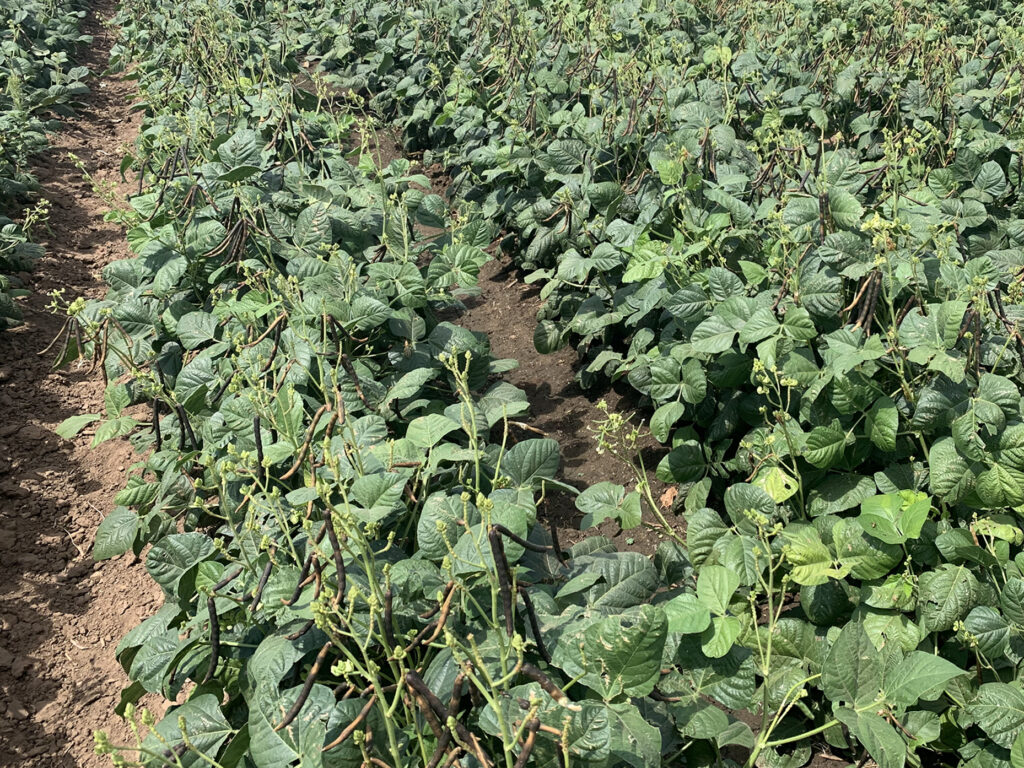College Station, Texas, USA
December 6, 2023
Mung beans might be absent from many menus across the U.S., but Texas A&M AgriLife Research and AgriVentis Technologies are investigating the potential of this alternative protein source.

Waltram Ravelombola, Ph.D., a Texas A&M AgriLife Research organic and specialty crop breeder in Vernon, is conducting variety trials for mung beans across Texas. (Texas A&M AgriLife photo)
Mung beans are a legume that is good for both the body and the soil, but few are currently grown in the U.S. A small acreage exists in Texas, Oklahoma and California, but a growing market is prompting larger interest in finding varieties that will flourish throughout Texas.
Mung beans offer health and environmental benefits to producers who introduce them into their cropping systems, said Waltram Ravelombola, Ph.D., an AgriLife Research organic and specialty crop breeder at the Texas A&M AgriLife Research and Extension Center at Vernon and the Texas A&M Department of Soil and Crop Sciences.
AgriVentis approached Ravelombola and AgriLife Research about conducting variety trials for their mung beans to measure their adaptation to Texas production.
“Mung bean is a legume that provides a high-quality protein for humans, and it also helps farmers diversify a producer’s crop rotation,” Ravelombola said. “They can be double cropped with winter wheat, for example, or put into a rotation such as cotton and mung bean.”
Testing varieties for adaptability
For instance, he said, AgriVentis wants to reach the plant-based protein industry. An example would be a California company’s annual reliance on more than 25,000 tons of imported mung beans due to low U.S. production. Other uses are as sprouts and in soups.
“They are importing mung beans, and we know here, especially in the southern U.S., we have the potential to grow the crop and help our farmers at the same time,” Ravelombola said. “So, there is a potential market.”
He said mung beans do well across Texas climates. They are drought and heat tolerant. However, if grown under humid conditions, they are susceptible to bacterial disease. They can also have an issue with blister beetles if not sprayed.
“We don’t know yet how widely adapted they are in Texas, and that’s where the interest is in conducting the statewide trials,” Ravelombola said.
Over the summer, he grew mung beans in four locations: Vernon, Lubbock, Stephenville and Corpus Christi. Others within the Department of Soil and Crop Sciences helping with his trials are Calvin Trostle, Ph.D., Texas A&M AgriLife Extension Service agronomist, Lubbock; Josh McGinty, Ph.D., AgriLife Extension agronomist, and Jonathan Ramirez, AgriLife Extension program associate, both in Corpus Christi; and John Cason, Ph.D., AgriLife Research peanut breeder, Stephenville.
“We wanted to see how widely adapted mung bean is across the state of Texas, and our two-year data shows there are varieties that have potential and perform better than the checks,” he said.
Growing mung beans in Texas
Mung beans can be planted from late April to early July and are harvested in September or October. They are harvested with a combine, so farmers adding the crop to their rotation would not need any new equipment. After harvest, they are cleaned and sent to an elevator and graded.
 Mung beans growing near Vernon. (Texas A&M AgriLife photo)
Mung beans growing near Vernon. (Texas A&M AgriLife photo)
There are three characteristics manufacturers look for: percentage of splits, brightness and disease damage to the beans. Customers and manufacturers like mung beans that are bright in color. That is key in terms of processing.
As a legume, they can fix atmospheric nitrogen and bring more nitrogen to the following crop.
“Let’s say we have the wheat and mung bean rotation — the wheat crop following mung beans will have a nitrogen supplement,” Ravelombola said.
Ravelombola said his team is only conducting variety adaptation trials for now. They are testing four varieties, two from AgriVentis and two that originated in Oklahoma — Berken and OK 2000. Ravelombola said there have been discussions with seed companies, and there are plans to have a field day in 2024 for producers to see the varieties.
“Right now, we are growing seeds for our producers, and then they will grow the mung beans for the market,” he said.
Ravelombola said he envisions an increase in seed grown next year compared to 2023.